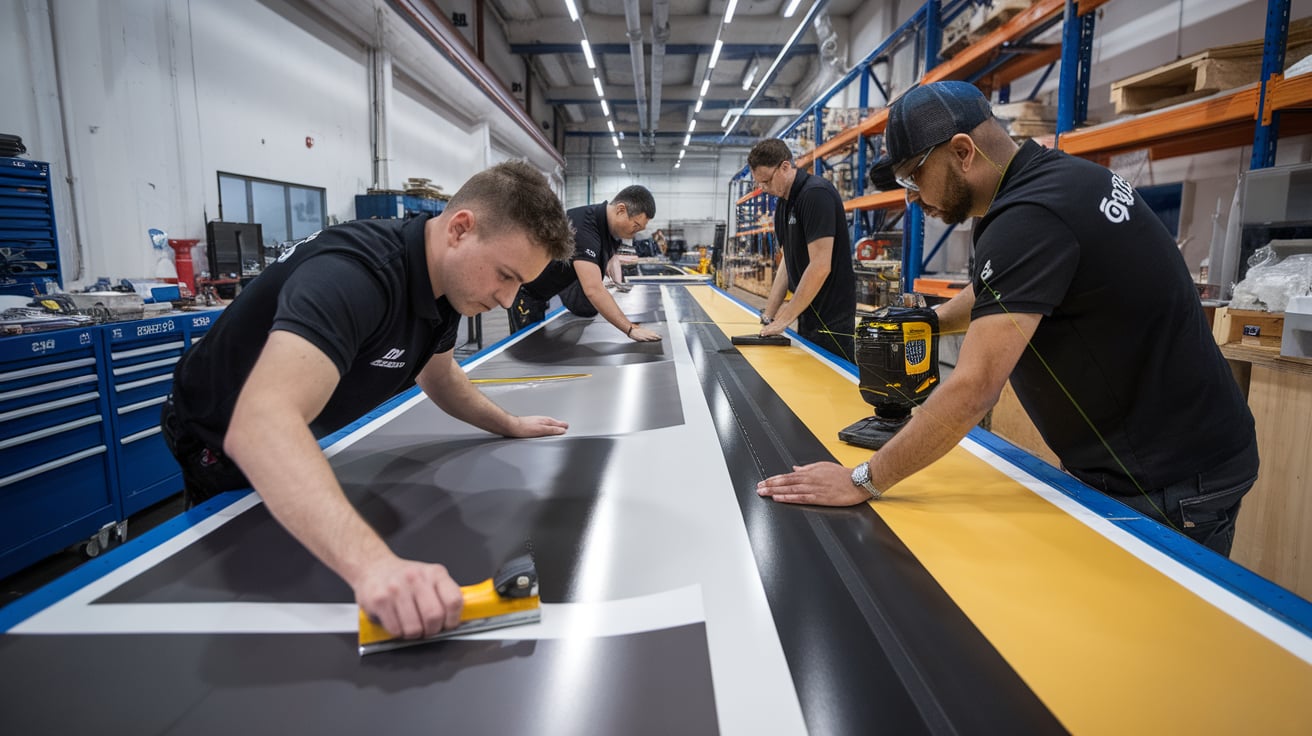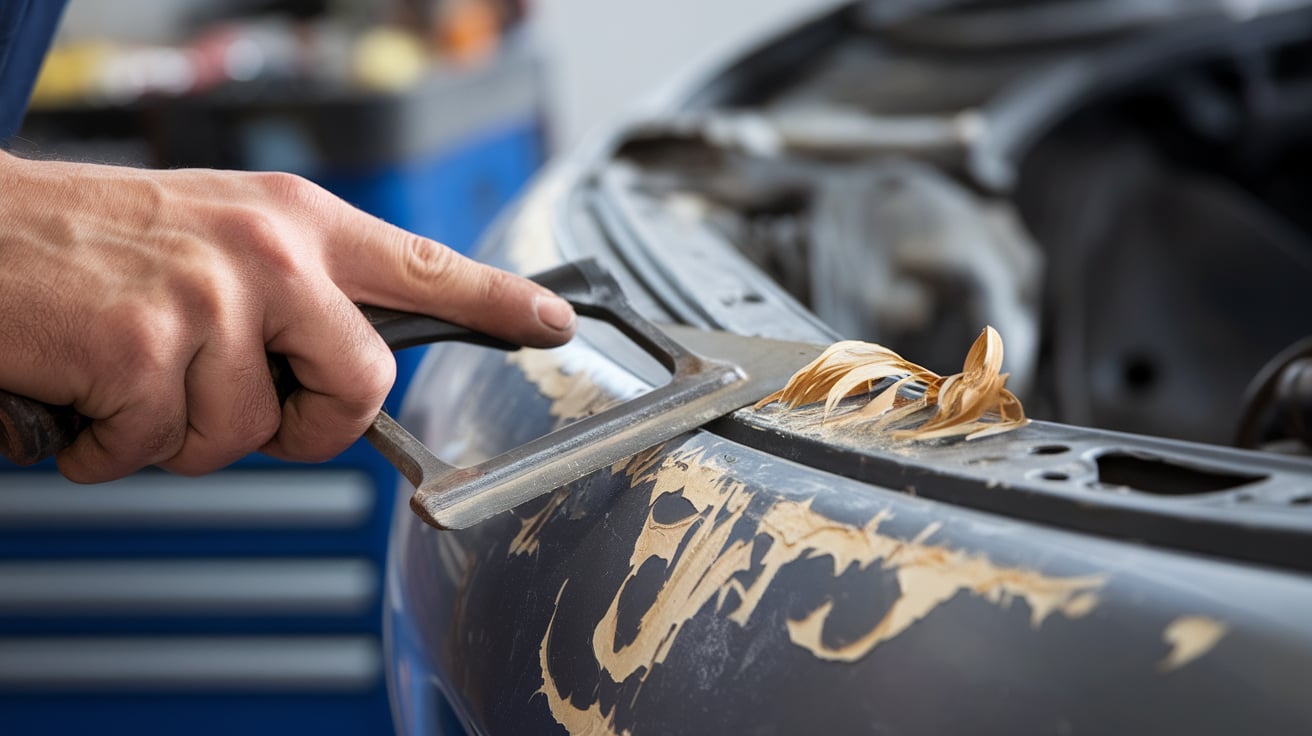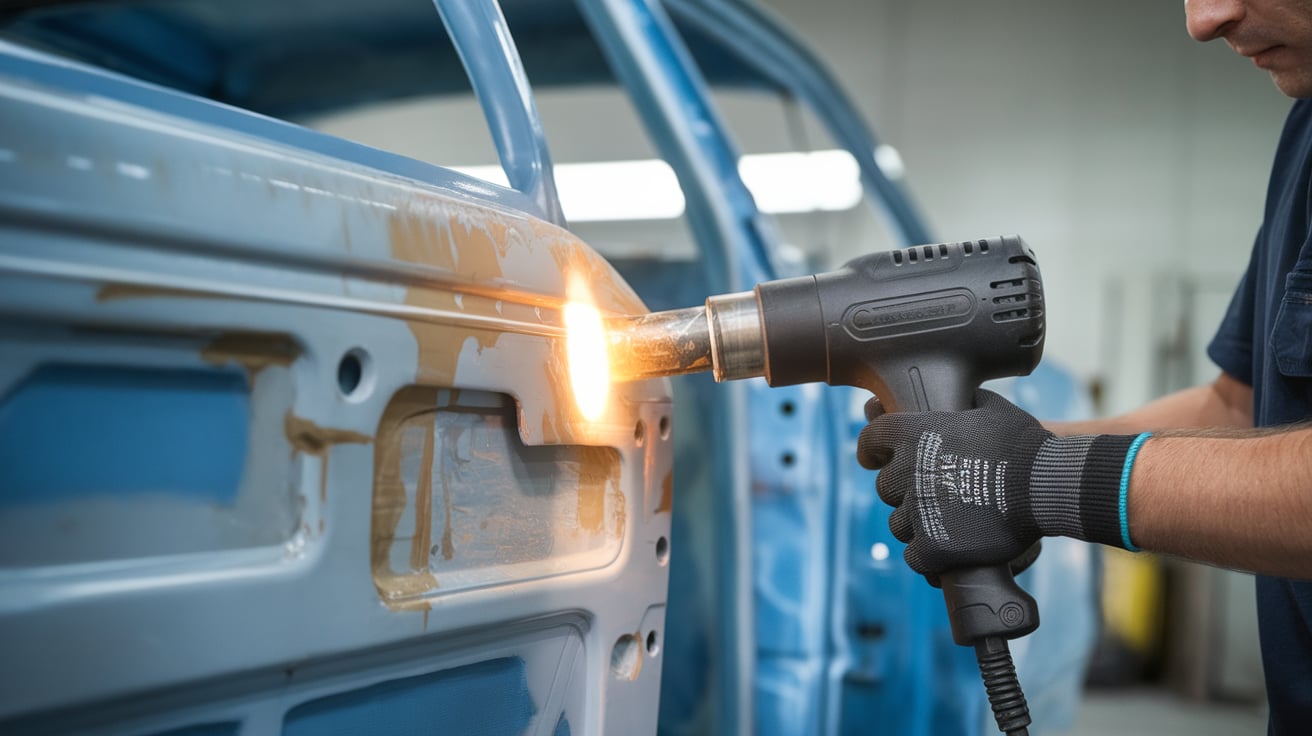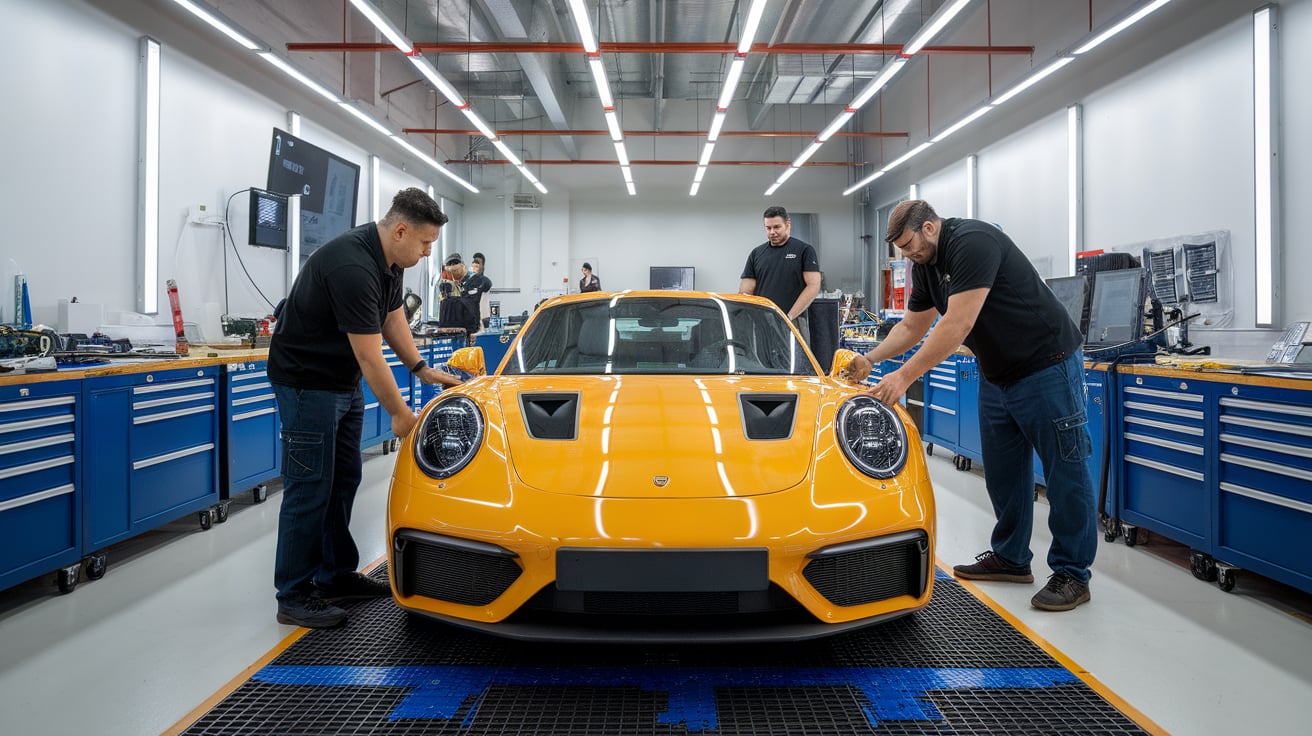Ever looked at an old paint job and thought, how did this mess even happen? Scratches, peeling, flaking, and that sun-baked finish, not exactly what anyone wants to see. If you run a car body shop, you already know this: car paint removal is not just about stripping off color. It is about prepping the surface for something better, something clean. Whether it is a full respray or a dent repair, getting the old layers off the right way changes everything. Let’s talk tools, the real ones that actually get it done.
Manual vs. Powered Paint Removal | What’s the Difference?
So here is the thing, not all paint removal tools for cars work the same way, and picking the wrong one can turn a quick fix into a full-blown disaster. Ever tried using a power sander on a tight edge near a window trim? That is how mistakes get made. Choosing between manual and powered paint removal tools is about knowing what the job demands, not just grabbing whatever’s close.
Manual Paint Removal Tools
There is something about the control you get with a manual paint scraper. You feel the resistance. You see what is coming off. You do not overdo it.
- Ideal for tight corners, mouldings, and filler lines
- Helps when doing fine-detail corrections or spot repairs
- Handy when blending old paint with new panels
You are not using brute force here, you are carving, shaping, preparing.
If you are fixing a small dent or working near sensitive trim, a manual scraper lets you stay precise. It is not fast, but it saves you from burning through the wrong layer.
Powered Paint Removal Tools
Now if you are working on a full door respray or removing four layers of factory paint on a hood, forget the hand tools. You need a powered paint stripper that moves fast and keeps up.
- Used with sanding discs, wire wheels, or stripping pads
- Best for full panel prep, especially on aged paint
- A must-have in busy car bodyshop setups
High-volume work means no time to scrape by hand. A powered paint stripper gets you clean metal in half the time, but only when you know how to handle it.
Whether you are going slow and careful or all-in with power, choosing the right paint removal tool for cars saves time, surface, and sanity. If you’d rather have a pro handle the prep, our Dubai auto body experts can strip, prep, and refinish to factory standards.

Tool 1: Dual Action (DA) Sander
Ever tried sanding paint with just your hands and some grit paper? You probably gave up halfway. Or worse, left swirl marks everywhere. That is where the DA sander, also called a dual action sander, steps in. This isn’t just another random paint stripping tool; it’s the one that gives you control without sacrificing speed.
A DA sander moves in two ways at once, it spins and it vibrates. That combo keeps it from digging too deep in one spot. It smooths out old layers of paint, primer, even body filler, without chewing up the surface underneath.
What makes the DA sander a go-to paint stripping tool?
- It gives a swirl-free finish, no ugly spiral patterns when you’re done
- Perfect for leveling out filler or feathering paint edges
- You can load it with various sanding grits, coarse for stripping, fine for finishing
- Works on curves, doors, hoods, bumpers, all the awkward spots that need finesse
Want consistent results? Want to avoid redo jobs? Then forget elbow grease, the dual action sander earns its spot in every serious car bodyshop.
Tool 2: Rotary Paint Stripping Disc
There is removing paint, and then there is ripping it off like it owes you money. If you need speed and aggression, a paint stripping disc mounted on a rotary tool brings the heat. This is not finesse. This is force. And when used right, it gets bare metal in minutes. Unlike orbital tools, this one spins on a single axis. Fast. Relentless. It scrubs away thick layers of paint, rust, and primer, especially on large flat panels like doors, roofs, or tailgates.
Why use a rotary paint stripping disc?
- Removes multiple layers of old paint fast
- Ideal for prepping panels for welding, respray, or restoration
- Works well with angle grinders or electric drills
- Handles flat surfaces better than most sanders
- Cuts through hardened filler and primer without mercy
This paint removal tool for cars is unforgiving on curves and edges. Hold it wrong and you will dig trenches into the panel. Use it right, and it clears decades of junk paint in seconds. Sometimes paint removal goes hand-in-hand with dent correction, see how slide hammer kits tackle deeper metalwork before refinishing.”
Tool 3: Chemical Paint Removers
Not every job needs brute force. Sometimes, the smarter move is to let chemistry do the heavy lifting. When you are dealing with fragile panels, plastic parts, or tricky curves, a chemical paint remover steps in where abrasives fall short. You brush it on, and watch the layers bubble, crack, and lift. No noise. No sparks. Just slow, controlled breakdown.
This kind of car paint removal is especially useful when working around badges, seams, or interior trims where power tools just make a mess.
Why go chemical?
- Penetrates tight spots power tools can’t reach
- Less risk of panel warping, especially on aluminum or plastic
- Great for classic cars with flaky, sun-baked finishes
- Minimal surface scratching, perfect if you’re preserving original lines
Most paint removal chemicals come in gel form. That keeps them from running everywhere. Apply with a brush. Let it sit. Then scrape it off gently with a plastic blade or cloth. For drivers looking for flexible finishes, peelable car paint offers a reversible way to refresh panels after proper stripping.
Tool 4: Sandblasting Kit
Alright, let’s talk about the heavy-duty stuff. When nothing else works, when layers of paint, primer, rust, and undercoat are caked on like old chewing gum, you pull out the sandblasting kit. This is not gentle. It is raw. It is loud. And it clears everything in its path.
A proper sandblasting paint removal setup uses compressed air to fire abrasive media at high speed. It scrapes surfaces clean without physically touching them. That means no swirl marks, no sanding patterns, just bare metal or plastic, ready to work on.
What makes a sandblasting kit so powerful?
- Strips paint, rust, filler, and undercoating all at once
- Works fast on entire panels, wheels, chassis frames
- Blasts into corners, welds, and seams that grinders can’t reach
- Can be adjusted for soft or aggressive surfaces using different media
In any car bodyshop, especially in Dubai where corrosion from sea air hits hard, a sandblasting paint removal tool is not a luxury. It is survival gear.
Tool 5: Paint Scraper with Replaceable Blades
Old school? Yes. Useless? Not even close. There are moments when no machine, no spray, no sand can replace the simple control of a manual paint scraper. Especially one with a sharp, replaceable blade. When you are working close to trim, badges, or a fuel cap edge, precision is not optional, it is everything.
You can feel what is coming off. You can see what is staying on. That tactile feedback makes a difference when dealing with delicate surfaces.
Why keep this tool in your kit?
- Excellent for detail work and cleanup after sanding or chemical stripping
- Gets into tight spots where DA sanders or discs won’t fit
- Blade swaps keep the tool fresh and effective
- Safe to use on plastics and fiberglass with the right blade
You are not clearing entire panels with this. You are cleaning up behind the bigger tools, getting the bits they missed. Or maybe you are doing light prep on an edge that just needs smoothing.

Tool 6: Infrared Paint Curing & Softening Tool
Let’s say you are staring at a car that has been baking under the Dubai sun for ten years straight. The paint is brittle. The clear coat looks like desert cracks. Now try scraping or sanding that, you will either flake it all unevenly or dig straight into the primer. This is where an infrared paint removal tool quietly becomes your best friend. It is not about burning the paint off, it is about softening it just enough to lift it cleanly.
Why use infrared for paint removal?
- Gently softens aged or hardened paint without melting plastic
- Helps loosen multiple paint layers without chemicals or sanding
- Perfect for prepping bumpers, mirror covers, or door handles
- Speeds up paint stripping when used before manual or mechanical removal
This tool works by heating the paint from underneath using infrared wavelengths, not just hot air blowing around. It penetrates the layers and makes them bubble from the bond layer upward. That’s what lets you peel it back instead of scraping it to death.
Tool 7: Wire Brush Drill Attachments
You ever had one of those jobs where paint, rust, and undercoating are all stuck together like they signed a contract? Yeah, that is when you grab a wire brush attachment for your drill and stop messing around. It is not pretty, but it works. Especially for frame rails, weld joints, and weird underbody spots where other tools just bounce off.
It spins fast, scrapes hard, and reaches where discs and sanders tap out. This is your clean-up crew with teeth.
Where does a wire brush drill tool shine?
- Blasts through rust and flaking paint in seconds
- Excellent for prep work before sealing or undercoating
- Comes in all shapes, cup, cone, wheel, to fit tricky spots
- Can be paired with a cordless drill for mobile repairs
And here’s the thing, it is not just about car paint removal. These brushes take off old sealant, mud, even corrosion inside wheel wells. You are cleaning the canvas before the art even starts.
Tool 8: Flap Discs for Angle Grinder
This is where paint removal starts feeling less like bodywork and more like controlled destruction, the good kind. A flap disc attached to an angle grinder does not waste time. It shaves off paint, filler, rust, even light welds, and does it fast. If you are in a hurry, or working on a panel that is been through a few paint jobs too many, this is the shortcut you take. But be warned, this tool will expose your mistakes as fast as it removes paint.
Why flap discs are a game-changer in car paint removal:
- Removes multiple layers in a single pass
- Doubles as a grinding and sanding tool
- Available in a wide grit range (from 36 to 120+)
- Works great on doors, roof skins, trunk lids, anywhere flat and wide
What makes flap discs different from regular grinding wheels is how they are built, overlapping strips of sandpaper bonded to a backing plate. That means you get both cutting and blending in one go.
Tool 9: Media Blaster Cabinet (For Small Parts)
Ever tried removing paint from a set of lug nuts, brackets, or a vintage emblem without damaging the details? Not happening, unless you are using a media blaster cabinet. This thing is like a sandblaster, but mini and controlled. You load the part in, close the hatch, and blast it inside a sealed chamber. No mess, no flying debris, no ruined shop clothes.
For a car bodyshop that handles restorations or detailed part refinishing, this tool is gold.
Why a media blasting cabinet belongs in your shop:
- Perfect for small parts like nuts, bolts, badges, brackets
- Keeps blasting controlled and clean, no overspray
- Works with a variety of abrasive media
- Allows detailed cleaning without losing sharp edges or stamped markings
You can use soda media for gentle cleaning, crushed glass for aggressive stripping, or even walnut shells if you are being delicate. The point is, this gives you options, and keeps the mess off your floor.
Tool 10: Nylon Surface Conditioning Discs
Let’s say you’ve done the hard part, you’ve stripped the paint, leveled the filler, smoothed out the primer. Now what? You do not just throw color on raw metal and hope for the best. You need to prep that surface like it is about to hit the showroom. That’s where nylon surface conditioning discs earn their keep.
These aren’t for removing layers, they’re for perfecting what’s left behind.

What makes nylon conditioning discs worth using?
- Blends out sanding scratches, swirl marks, and sharp edges
- Ideal for prepping before primer, sealant, or base coat
- Works well on metal, aluminum, even plastic
- Non-woven design avoids overheating and gouging
Think of it like buffing out your mistakes, without making new ones. The nylon disc gently scuffs the surface just enough for primer to stick, without damaging contours or changing panel shape. It is a surface cleaner, a polisher, and a safety net all in one.
How to Use These Tools Efficiently in Your Car Bodyshop
Having all the right car paint removal tools is one thing, knowing how to actually use them together without wasting time or damaging panels is a whole other story. In a fast-moving bodyshop, efficiency is what separates solid work from repainting regrets. Here is how to streamline your workflow and make every tool count without going in circles.
- Start with a Proper Inspection: Before reaching for any tool, assess the panel. Check paint thickness, type of damage, panel material (steel, aluminum, plastic). This saves you from over-stripping or using the wrong tool for the surface.
- Choose the Right Tool for the Right Job: Do not default to power tools. Small spots? Use a manual scraper. Fragile plastic? Try chemical paint remover. Whole panels with rust? That is flap disc or sandblaster territory.
- Work in Layers, Not Chaos: Strip in stages. First layer: old clear coat. Second layer: paint. Final layer: primer or filler. Trying to blast it all off at once just wastes time and wears out your tools fast.
- Keep Your Tools Prepped and Organized: A dull blade or clogged disc slows everything down. Clean, replace, and organize tools so you’re not hunting for a flap disc mid-job or switching out sanding grits in frustration.
- End With a Clean Surface Check: Once stripped, wipe panels with degreaser or isopropyl alcohol. Check under natural light. Any residue, leftover adhesive, or swirl? Hit it again, better now than during primer.
Smooth car paint removal is not just about power or speed. It is about timing, order, and knowing when to go easy or go hard. A sharp team with sharp tools? That is where real quality comes from.
Common Mistakes When Removing Car Paint
Even with the right paint removal tools, poor technique can ruin a panel. These are the mistakes that waste time, damage surfaces, and lead to rework. It’s not only panels that need careful prep, interior dashboard repair in Dubai also demands the right tools to avoid cracks and mismatched finishes.
- Wrong Grit Use
Using coarse grit like 36 on thin metal causes deep scratches or warping. Match grit to the job. - Overheating the Panel
Holding sanders or heat tools too long in one spot leads to warping, especially on aluminum. - Skipping Cleanup
Leaving behind dust, chemicals, or residue leads to paint failure later. Wipe and degrease often. - Not Testing Chemicals First
Some removers react with filler or aftermarket paint. Always test on a small spot before full application. - Ignoring Edges and Seams
Tools often miss curves and tight corners. Scrape those manually or the new paint will lift later.
Quick Tip:Take your time early, or spend twice as long fixing it later. Paint removal is surface prep, not speed racing.
When to Strip Paint Completely vs. Spot Sanding
Not every job needs a full-blown paint strip. But some? You’d be wasting your time just sanding around. So how do you decide? Here’s a simple breakdown, no fluff, just real scenarios you’ll actually deal with in the workshop:
| What You’re Looking At | Go for Full Paint Removal | Spot Sanding Is Enough When… |
| Paint’s condition | It’s old, faded, or cracking like dry skin under Dubai sun | Still smooth, glossy, and holding well, maybe just a few scratches |
| Rust situation | There%E |



